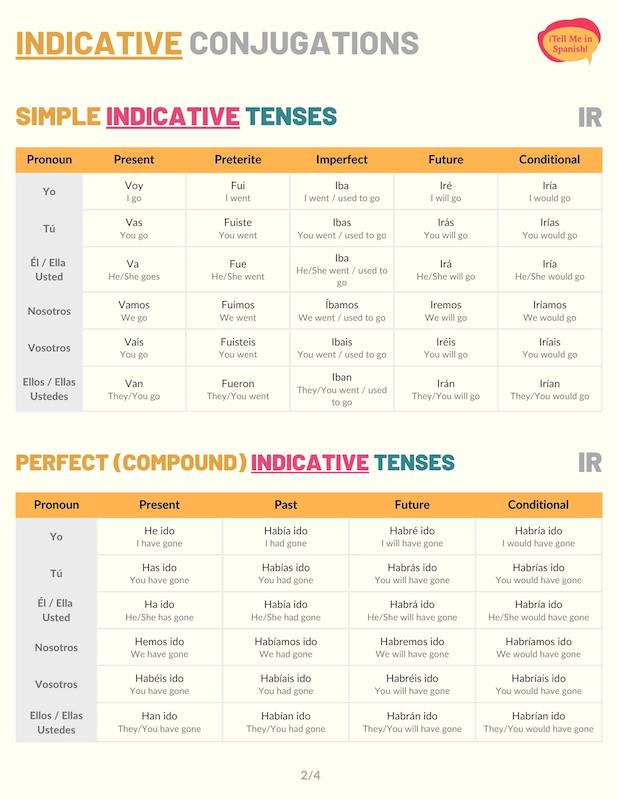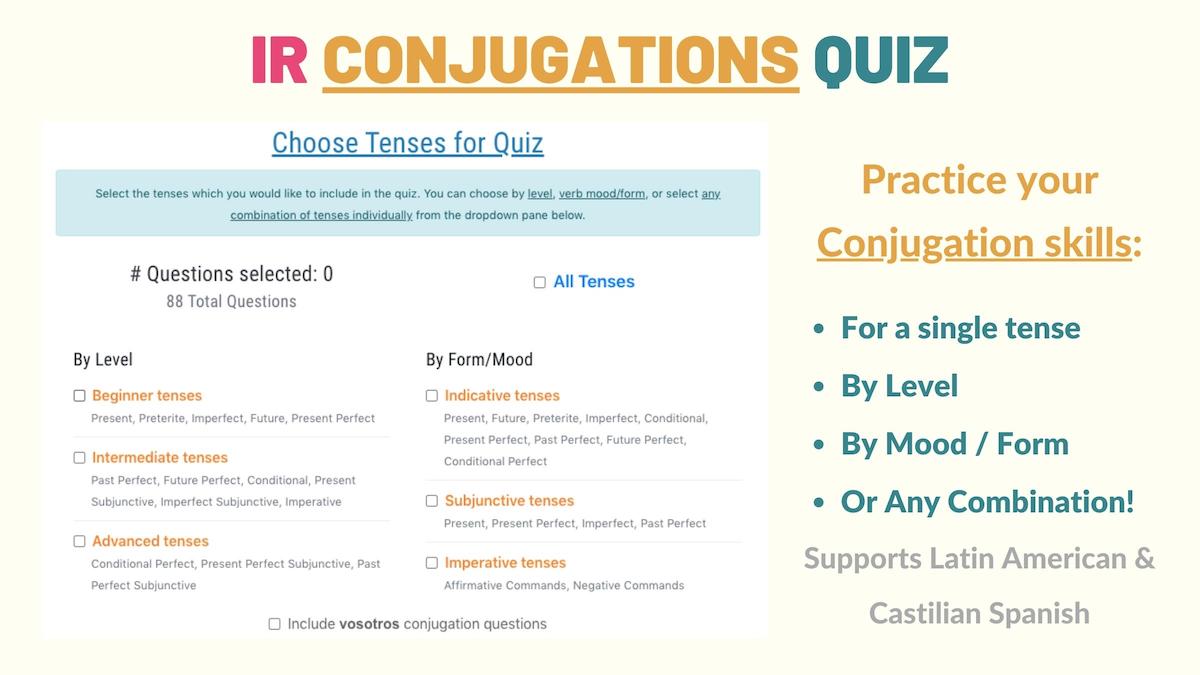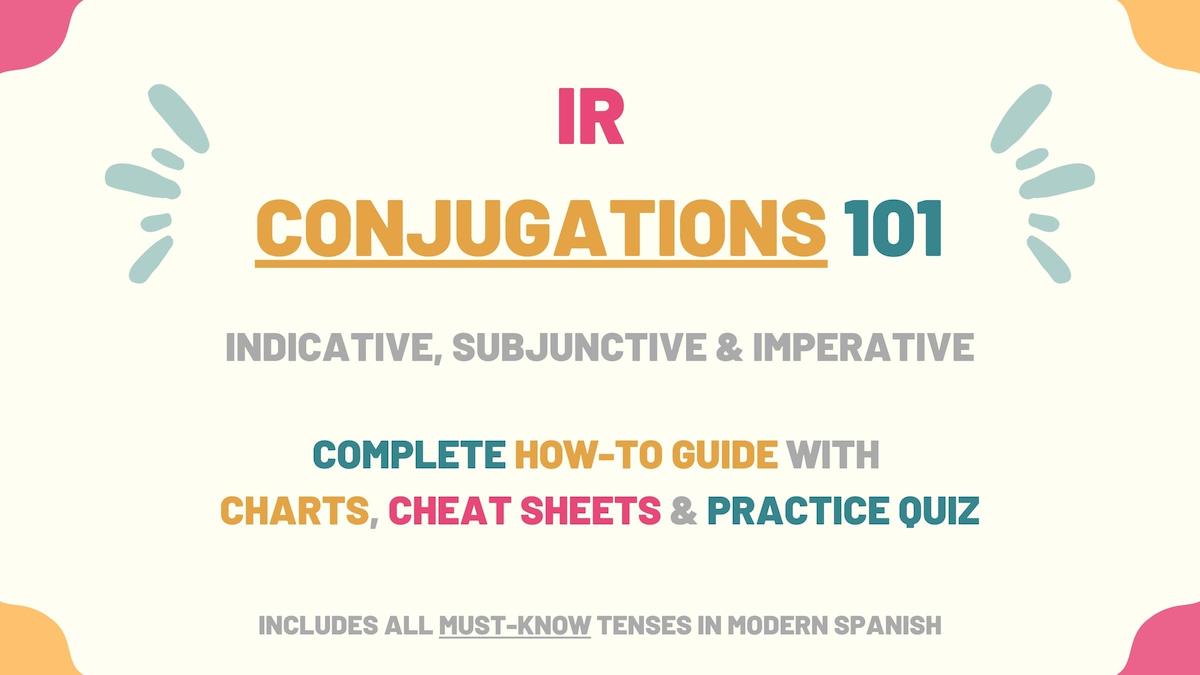Ir is one of the most common irregular verbs in Spanish. Since it has irregularities in most tenses, we’ll go over all the ir conjugation patterns you need to know in this guide. Here is an overview of what we’ll learn:
- Ir Overview
- Indicative Tenses of Ir Conjugations
- Subjunctive Tenses of Ir Conjugations
- Imperative (Commands) of Ir Conjugations
- Uses & Examples
- Download Ir Conjugation Tables & Uses Cheat sheets
- Ir Conjugation Practice Quiz
Overview of Ir
| Verb Characteristic | Property |
|---|---|
| Verb Type | -IR |
| Irregular | Yes |
| Infinitive | Ir |
| Gerund (Present Participle) Form | Yendo |
| Past Participle Form | Ido |
| Synonyms | Salir, dirigirse. |
Stem Changes:
- Present Indicative: voy only for ‘yo’, va for all subject pronouns.
- Preterite: fui for all subject pronouns, fue for the third person singular and plural.
- Imperfect Indicative: iba for all subject pronouns.
- Present Subjunctive: vay for all subject pronouns.
- Imperfect Subjunctive: fuefor all subject pronouns.
- Affirmative Imperative: ve for ‘tú’, vay for ‘usted’, and ‘ustedes’.
- Negative Imperative: vay for all subject pronouns.
Indicative Conjugations of Ir
Present tense
Ir present tense conjugations are irregular for all subject pronouns. For the yo form, use the irregular ending -oy. The remaining subject pronouns are conjugated with the stem v and no accent marks.
The present conjugations of ir are used to talk about the places a person currently goes. These forms are also used to conjugate verbs to the near future in Spanish. For example: Ellas van a la tienda.
| Person | Conjugation | Translation |
|---|---|---|
| Yo | Voy | I go |
| Tú | Vas | You go |
| Él / Ella Usted | Va | He/She goes You (formal) go |
| Nosotros | Vamos | We go |
| Vosotros | Vais | You go |
| Ellos / Ellas Ustedes | Van | They go You (plural) go |
Take Note: In Spanish, –oy is an irregular ending to form the conjugation yo for certain irregular verbs, such as estar, dar, and ser.
Preterite tense
Ir’s preterite conjugations are formed with the stems fue for the third-person singular and plural and fui for the remaining subject pronouns. You can see how to conjugate ir in the conjugation chart below.
When in the past preterite form, ‘ir’ communicates that someone went to a place at a specific moment in the past. For example: ¿Fuiste a la fiesta de Nancy?
| Person | Conjugation | Translation |
|---|---|---|
| Yo | Fui | I went |
| Tú | Fuiste | You went |
| Él / Ella Usted | Fue | He/She went You (formal) went |
| Nosotros | Fuimos | We went |
| Vosotros | Fuisteis | You went |
| Ellos / Ellas Ustedes | Fueron | They went You (plural) went |
Take Note: In the preterite tense, ir and the verb ser have the same conjugation. You must pay attention to the sentence’s context and elements to know which verb is being applied.
Imperfect tense
The imperfect conjugations of ir are formed with the stem ‘ib-’. Conjugate ir to the imperfect indicative tense to talk about the places people used to go repeatedly in the past. For example: Nosotros siempre íbamos a tus partidos de fútbol.
| Person | Conjugation | Translation |
|---|---|---|
| Yo | Iba | I went I used to go |
| Tú | Ibas | You went You used to go |
| Él / Ella Usted | Iba | He/She went He/She used to go You (formal) went You (formal) used to go |
| Nosotros | Íbamos | We went We used to go |
| Vosotros | Ibais | You went You used to go |
| Ellos / Ellas Ustedes | Iban | They went They used to go You (plural) went You (plural) used to go |
Near future
Ir (present tense) + a + infinitive (in this case, ‘ir’) is the structure you must use to form the immediate future of ‘ir’. Use these forms to express that a person will go somewhere soon in the future. An example is: ¿A qué hora vas a ir al dentista?
| Person | Conjugation | Translation |
|---|---|---|
| Yo | Voy a ir | I’m going to go |
| Tú | Vas a ir | You’re going to go |
| Él / Ella Usted | Va a ir | He/She is going to go You (formal) are going to go |
| Nosotros | Vamos a ir | We’re going to go |
| Vosotros | Vais a ir | You’re going to go |
| Ellos / Ellas Ustedes | Van a ir | They’re going to go You (plural) are going to go |
Take Note: Ir a + infinitive is used to talk about the future in Spanish. You need to make sure to change the infinitive verb to match the activity you’re talking about.
Future simple tense
Conjugate ir to the future simple tense to communicate that someone will go somewhere at some point in the future. For example: Nosotros iremos en un par de días.
| Person | Conjugation | Translation |
|---|---|---|
| Yo | Iré | I will go |
| Tú | Irás | You will go |
| Él / Ella Usted | Irá | He/She will go You (formal) will go |
| Nosotros | Iremos | We will go |
| Vosotros | Iréis | You (formal) will go |
| Ellos / Ellas Ustedes | Irán | They will go You (plural) will go |
Conditional tense
The Spanish conditional tense conjugations of ir express that people would go somewhere as long as some conditions are met. You can also omit the conditions and simply use these conjugations to say someone would go to a place.
For example: Yo iría a tu fiesta, pero tengo mucho trabajo.
| Person | Conjugation | Translation |
|---|---|---|
| Yo | Iría | I would go |
| Tú | Irías | You would go |
| Él / Ella Usted | Iría | He/She would go You (formal) would go |
| Nosotros | Iríamos | We would go |
| Vosotros | Iríais | You would go |
| Ellos / Ellas Ustedes | Irían | They would go You (plural) would go |
Present perfect tense
Haber in the present tense + ido (past participle) is the structure we use to form the present perfect in Spanish. Use these conjugations to talk about whether someone has or hasn’t gone somewhere. For instance: Tanya, ¿ya has ido a ese restaurante?
| Person | Conjugation | Translation |
|---|---|---|
| Yo | He ido | I have gone |
| Tú | Has ido | You have gone |
| Él / Ella Usted | Ha ido | He/She has gone You (formal) have gone |
| Nosotros | Hemos ido | We have gone |
| Vosotros | Habéis ido | You have gone |
| Ellos / Ellas Ustedes | Han ido | They have gone You (plural) have gone |
Past perfect
When conjugated to the past perfect tense in Spanish, ir communicates that someone had gone somewhere before another past action or time frame in the past. For example: A las 8, Juan ya se había ido.
To conjugate ir to the past perfect, use the imperfect form of ‘haber’ and the past participle form of ‘ir’.
| Person | Conjugation | Translation |
|---|---|---|
| Yo | Había ido | I had gone |
| Tú | Habías ido | You had gone |
| Él / Ella Usted | Había ido | He/She had gone You (formal) had gone |
| Nosotros | Habíamos ido | We had gone |
| Vosotros | Habíais ido | You had gone |
| Ellos / Ellas Ustedes | Habían ido | They had gone You (plural) had gone |
Future perfect
Ir conjugated to the future perfect tense expresses that someone will have gone or attended a place by or before a certain moment in the future. You can also use these forms to discuss where someone might have gone. ¿Sabes si Luis ya habrá ido a la farmacia?
| Person | Conjugation | Translation |
|---|---|---|
| Yo | Habré ido | I will have gone |
| Tú | Habrás ido | You will have gone |
| Él / Ella Usted | Habrá ido | He/She will have gone You (formal) will have gone |
| Nosotros | Habremos ido | We will have gone |
| Vosotros | Habréis ido | You will have gone |
| Ellos / Ellas Ustedes | Habrán ido | They will have gone You (plural) will have gone |
Conditional perfect
In Spanish, we use the verb ir conjugated to the conditional perfect for communicating that someone would have gone somewhere if a past action had been completed. For example: No habrías ido si no te hubiera insistido, ¿verdad?
| Person | Conjugation | Translation |
|---|---|---|
| Yo | Habría ido | I would have gone |
| Tú | Habrías ido | You would have gone |
| Él / Ella Usted | Habría ido | He/She would have gone You (formal) would have gone |
| Nosotros | Habríamos ido | We would have gone |
| Vosotros | Habríais ido | You would have gone |
| Ellos / Ellas Ustedes | Habrían ido | They would have gone You (plural) would have gone |
Progressive tenses
The progressive tenses of ir convey that someone is going somewhere at the moment of speaking. To conjugate to this tense use the formula estar conjugated + present participle (yendo). For instance: Mis hermanos están yendo a clases de pintura.
| Progressive Tense | Formula | Translation Example |
|---|---|---|
| Present | Estar (present) + yendo | I am going |
| Preterite | Estar (preterite) + yendo | You were going |
| Imperfect | Estar (imperfect) + yendo | He was going |
| Future | Estar (future) + yendo | We will be going |
| Conditional | Estar (conditional) + yendo | They would be going |
Take Note: Like ‘ir’, there are other Spanish verbs whose present participle forms are irregular or have some stem changes.
Ir Subjunctive Conjugations
The Spanish subjunctive mood is used to talk about wishes, requests, suggestions, expectations, doubts, or hypothetical situations. Below are the ir conjugation charts for the most common subjunctive tenses.
Present subjunctive
The verb ir subjunctive conjugations are formed with the irregular stem vay. We conjugate ‘ir’ to the present subjunctive tense to express hopes, suggestions, or requests about someone going somewhere. For instance: Mi mamá quiere que vayas a la tienda.
| Person | Conjugation | Translation |
|---|---|---|
| Yo | Vaya | I go |
| Tú | Vayas | You go |
| Él / Ella Usted | Vaya | He/She goes You (formal) go |
| Nosotros | Vayamos | We go |
| Vosotros | Vayáis | You go |
| Ellos / Ellas Ustedes | Vayan | They go You (plural) go |
Take Note: Que te vaya bien is one of the ways we say have a good day in Spanish. This structure is formed with the subjunctive forms of ‘ir’.
Present perfect subjunctive
The present perfect subjunctive of ‘ir’ is conjugated with the structure haber in the present subjunctive + ido. With this tense, this verb is used to wonder or wish that a person has already gone somewhere. For example: ¿Quién crees que haya ido a la reunión?
| Person | Conjugation | Translation |
|---|---|---|
| Yo | Haya ido | I have gone |
| Tú | Hayas ido | You have gone |
| Él / Ella Usted | Haya ido | He/She has gone You (formal) have gone |
| Nosotros | Hayamos ido | We have gone |
| Vosotros | Hayáis ido | You have gone |
| Ellos / Ellas Ustedes | Hayan ido | They have gone You (plural) have gone |
Imperfect subjunctive
Fue is the irregular stem used to conjugate ir to the Spanish imperfect subjunctive tense. Use these conjugations to talk about past suggestions, requests, wishes, or expectations you had about someone going somewhere. Te pedí que fueras a comprar leche.
Depending on the type of Spanish (Latin American or Castilian) you use, there are two conjugation models for the imperfect subjunctive:
Latin American Spanish version
| Person | Conjugation | Translation |
|---|---|---|
| Yo | Fuera | I went |
| Tú | Fueras | You went |
| Él / Ella Usted | Fuera | He/She went You (formal) went |
| Nosotros | Fuéramos | We went |
| Ellos / Ellas Ustedes | Fueran | They went You (plural) went |
Note: The conjugation chart above doesn’t include the ir conjugation for ‘vosotros’ since this pronoun is not used in Latin American Spanish.
Castilian Spanish version
| Person | Conjugation | Translation |
|---|---|---|
| Yo | Fuese | I went |
| Tú | Fueses | You went |
| Él / Ella Usted | Fuese | He/She went You (formal) went |
| Nosotros | Fuésemos | We went |
| Vosotros | Fueseis | You went |
| Ellos / Ellas Ustedes | Fuesen | They went You (plural) went |
Past perfect subjunctive
In the past perfect subjunctive, ir communicates that someone would have gone somewhere if a past action had occurred. These conjugations can also express regret related to had or hadn’t gone to a certain place.
For example: La película estuvo muy aburrida, ojalá no hubiéramos ido.
| Person | Conjugation | Translation |
|---|---|---|
| Yo | Hubiera ido | I had gone |
| Tú | Hubieras ido | You had gone |
| Él / Ella Usted | Hubiera ido | He/She had gone You (formal) had gone |
| Nosotros | Hubiéramos ido | We had gone |
| Vosotros | Hubierais ido | You had gone |
| Ellos / Ellas Ustedes | Hubieran ido | They had gone You (plural) had gone |
Ir Imperative Conjugations
To give commands in Spanish, we must use the imperative mood.
Affirmative commands
Ir’s affirmative command conjugations are formed with two different irregular stems. You can see these forms in the conjugation chart below. We use these imperative conjugations to order someone to go somewhere. Vayan a la tienda, por favor.
| Person | Conjugation | Translation |
|---|---|---|
| Tú | Ve | Go |
| Usted | Vaya | Go |
| Vosotros | Id | Go |
| Ustedes | Vayan | Go |
Negative commands
Use the negative command forms of ‘ir’ to order someone not to go somewhere. These conjugations are formed with the irregular stem vay. For example: No vayas, está lloviendo.
| Person | Conjugation | Translation |
|---|---|---|
| Tú | No vayas | Don’t go |
| Usted | No vaya | Don’t go |
| Vosotros | No vayáis | Don’t go |
| Ustedes | No vayan | Don’t go |
Meanings of Ir & Examples
Now that you’ve learned how to conjugate the verb ir in Spanish, here are some examples of how to use it:
- Talking about going to or attending a place
[Ir conjugated] + [complement]
Ayer fui al cine con mis amigas.
Yesterday, I went to the movies with my friends.
Iremos a una conferencia en Madrid.
We will attend a lecture in Madrid.
Take Note: When talking about going somewhere, the verb ‘ir’ works with a + article (un, el, and their variations). Remember that with masculine nouns, you’ll need to use the contraction al.
- Talking about leaving a place (reflexive form)
[Reflexive pronoun] + [ir conjugated]
¿Por qué te vas tan temprano?
Why are you going so early?
Mis amigos no quieren que me vaya.
My friends don’t want me to leave.
Take Note: Irse is the reflexive form of ‘ir’. It follows the same conjugation pattern with the only difference that you must use Spanish reflexive pronouns. Although it can also mean ‘to go’, most of the time, irse is translated as ‘to leave’. Here you can check other verbs that change meaning in their reflexive form.
Download Ir Conjugation Tables & Uses Cheat sheets

Ir is a very common verb which you’ll use on a daily basis in Spanish. It’s also an irregular verb, which can be a challenging barrier to learning it and levelling up your Spanish fluency. So, I’ve created a PDF you can download which contains all the ir conjugation charts as well as its meanings and uses with examples.
Practice Quiz: Ir Conjugation

Now that you’ve learned how to conjugate ir in Spanish, you should drill yourself on all its different tenses and its many irregular forms. Take the ir conjugation practice quiz to test your knowledge and also learn its conjugations by heart.



